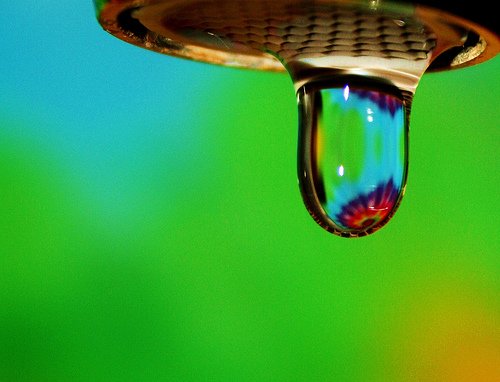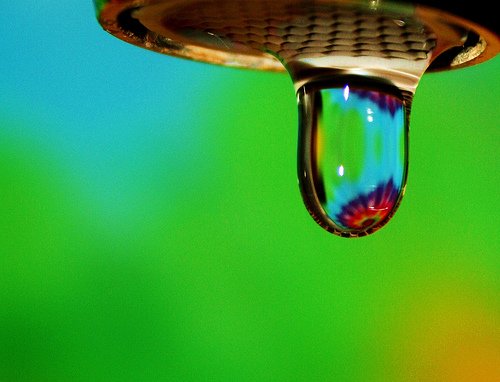 Flickr via Pink Sherbet PhotographyThe other day I came home to find a colorful flyer on my front door proclaiming, “Your meter just got smarter.”
Flickr via Pink Sherbet PhotographyThe other day I came home to find a colorful flyer on my front door proclaiming, “Your meter just got smarter.”
While I was out and about in Berkeley, a worker from my utility, PG&E, slipped in the side gate and gave my old gas and electric meter a digital upgrade. So-called smart meters allow the two-way transmission of electricity data and will eventually let me monitor and alter my energy consumption in near real-time. I’ll be able to fire up an app on my iPhone and see, for instance, a spike in watts because my son has left the lights on in his room and a laptop plugged in.
Now I only learn of my electricity use when I get my monthly utility bill, long after all that carbon has escaped into the atmosphere. The situation is even worse when it comes to water consumption; my bill and details of my water use arrive every other month.
“When you tell people what total bucket of water they used in the past 60 days, the barn door is open and the animals are long gone,” says Richard Harris, water conservation manager for the East Bay Municipal Utility District, my local water agency.
EBMUD is currently testing smart water meters in 30 households and plans to expand the pilot program to 4,000 homes and businesses later this year.
“It’ll give us better knowledge of where our water is going,” says Harris. “We also thought if we’re going to ask people to use water more efficiently, especially when we’re coming out of a drought and have imposed water restrictions, customers need to have an idea of what their current use is.”
EBMUD’s smart meters take readings every hour and participants in the pilot program will be able to go online to check their consumption and set up an email alert if their water use rises above a certain level. The agency also plans to offer a social networking feature to allow people to compare their water consumption with other households in the area. Nothing like a little peer pressure to get you to turn off the tap.
Given that many states expect to face water shortages in the coming years, one would think we’d be seeing a roll out of smart water meters akin to the national effort being made to smarten up the power grid.
The payoff could be enormous. Water agencies and consumers would be able to detect leaking pipes and toilets in real-time and fix the problem before the water literally goes down the drain.
Imagine a video screen in your shower that displays how many gallons that long hot shower is consuming. Smart water meters would also open the door to financial incentives to get people to use less water and penalize water hogs. (That said, politically powerful agribusiness remains by far the biggest water user.)
“You don’t need to send someone out to read the meter or roll a truck to connect or disconnect a meter,” says Guerry Waters, vice president for industry strategy at Oracle Utilities, a division of the Silicon Valley software giant. “Smart water meters can help you manage assets and detect leaks. There’s a staggering amount of water lost to leaks.”
Yet, according to a recent report by Oracle, while 68 percent of 300 American and Canadian water managers surveyed said they believe that smart water meters are crucial, 64 percent of them have no plans to install them.
Why? Money.
Nearly all water providers are public agencies, which means they’re strapped for cash and already facing a long list of capital improvement projects. The electric utility industry, on the other hand, is largely private and can either make the capital investments necessary for, say, a smart meter roll out, or can obtain regulators’ approval to raise rates to cover the costs.
In fact, 75 percent of the water managers surveyed said the capital costs of smart water meters was their main roadblock to rolling out such a program.
That presents a conundrum to companies like Oracle, which already sells software and services to water districts, hoping to tap a potentially vast smart water meter market.
IBM, meanwhile, has developed sensor networks and software it hopes to market to water districts to give them real-time data on water quality and to help manage their pipelines and infrastructure.
“Water districts don’t have the funding and have to find a way to pay for these systems,” Drew Clark, director of strategy for IBM’s Venture Capital Group, told me last year. “There’s this whole issue of how do we put this intelligence in water systems in a way that’s affordable for the ratepayers.”
One solution would be to devote some stimulus money or other federal largesse to underwrite a rollout of smart meters.
But Tom Blaisdel, a venture capitalist with DCM in Silicon Valley, thinks markets are the answer. “The problem in water is usually not a lack of technology but a lack of economic drivers to get people to adopt the technology,” he says. “Until you have market pricing you won’t have innovation and investment.”
Putting aside agricultural use — which in California is a political minefield — residential water pricing tends to be driven by drought and conservation mandates. As California’s drought dragged on, EBMUD and other water agencies imposed a tiered pricing structure that bumped up rates for water hogs.
For Harris, the future of water conservation lies more in providing data to customers rather than such things as rebates for water-efficient toilets.
“It’s all about giving customers a smart water toolbox,” he says.


